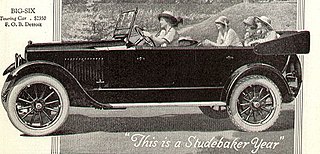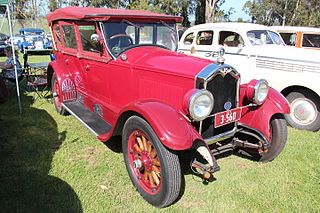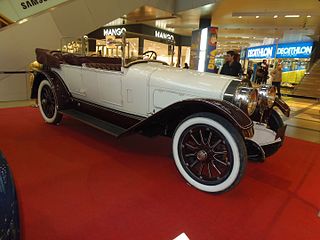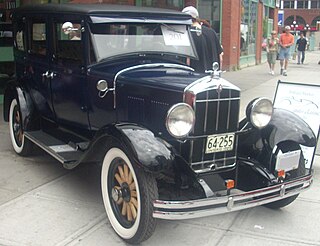This article relies largely or entirely on a single source .(June 2016) |
The Apperson Six Sport Sedan was a car manufactured by the Apperson Company of Kokomo, Indiana.
This article relies largely or entirely on a single source .(June 2016) |
The Apperson Six Sport Sedan was a car manufactured by the Apperson Company of Kokomo, Indiana.
New car price included the following items:
The following was available at an extra cost:
New car prices were F.O.B. factory, plus Tax:

The Oldsmobile 98 is the full-size flagship model of Oldsmobile that was produced from 1940 until 1942, and then from 1946 to 1996. The name – reflecting a "Series 90" fitted with an 8-cylinder engine – first appeared in 1941 and was used again after American consumer automobile production resumed post-World War II. It was, as it would remain, the division's top-of-the-line model, with lesser Oldsmobiles having lower numbers such as the A-body 66 and 68, and the B-body 76 and 78. The Series 60 was retired in 1949, the same year the Oldsmobile 78 was replaced by the 88. The Oldsmobile 76 was retired after 1950. This left the two remaining number-names to carry on into the 1990s as the bread and butter of the full-size Oldsmobile lineup until the Eighty Eight-based Regency replaced the 98 in 1997.

The Chrysler Imperial, introduced in 1926, was Chrysler's top-of-the-line vehicle for much of its history. Models were produced with the Chrysler name until 1954, after which it became a standalone brand; and again from 1990 to 1993. The company positioned the cars as a prestige marque to rival Cadillac, Continental, Lincoln, Duesenberg, Pierce Arrow, Cord, and Packard. According to Antique Automobile, "The adjective ‘imperial’ according to Webster's Dictionary means sovereign, supreme, superior or of unusual size or excellence. The word imperial thus justly befits Chrysler's highest priced model."

The Studebaker Big Six was an automobile produced by the Studebaker Corporation of South Bend, Indiana between 1918 and 1926, being designated the Model EG (1918–21), the EK (1922–24) and the EP (1925–26); its name was due to the 127" wheelbase in comparison to the Studebaker Special Six at 120". In 1927, it was renamed the President (ES) pending introduction of a smaller and smoother straight-eight engine for new top-of-the-range models after January 1928.

The Studebaker Light Six was a car built by the Studebaker Corporation of South Bend, Indiana from 1918 to 1927. It shared its wheelbase and standard equipment items with the Studebaker Light Four and was upgraded to the Studebaker Dictator in 1928.

The Studebaker Special Six was a car built by the Studebaker Corporation of South Bend, Indiana from 1918 to 1927.
Hupmobile Club Sedan – R was a vehicle produced by the Hupp Motor Company.
The Essex Coach was manufactured by the Essex Motor Company in Detroit, Michigan.

The Buick Standard Six Series 20 was manufactured by Buick at the Flint Wagon Works factory of Flint, Michigan, and was the junior model to the Buick Master Six between 1925 through 1929, and shared the GM A platform with Oldsmobile, Oakland and Chevrolet. The Standard Six evolved from the earlier Buick Six when the Buick 4-cylinder was cancelled. The Standard Six was the most popular Buick sold while being more upscale to the Oldsmobile Six. It was the senior brand to Marquette under the General Motors Companion Make Program until Marquette was cancelled one year later. It replaced the earlier Buick Six that was introduced in 1916, and was replaced with the Buick Series 50. Coachwork continued to be offered by Fisher Body who was the primary supplier of all GM products at this time, and Duco automotive lacquer paint, introduced by DuPont was the first quick drying multi-color line of nitrocellulose lacquers made especially for the automotive industry.

The Chandler Metropolitan Sedan was manufactured by the Chandler Motor Car Company of Cleveland, Ohio.
The Franklin Sedan was manufactured by the H. H. Franklin Manufacturing Company Company of Syracuse, New York.
The Jewett Five-Passenger Coach was manufactured for the Jewett marque of the Paige-Detroit Motor Car Company of Detroit, Michigan.

The Locomobile Sportif was a vintage era luxury car model manufactured by the Locomobile Company of America.

The Auburn 8-Eighty-Eight sedan is an automobile that was manufactured by Auburn of Auburn, Indiana.
The Cunningham Inside-Drive Limousine-146-A was manufactured by the Cunningham Carriage Company which produced luxury automobiles between 1908 and 1931.

The Durant Touring Car was manufactured by Durant Motors, Inc.
The Elcar Seven Passenger Sedan-8-80 was manufactured by Elkhart Carriage Company of Elkhart, Indiana.
The Flint Six "55" Four Door Brougham was manufactured by Flint Motors Division of Flint, Michigan.
The Star Two Door Sedan was manufactured by the Star division of Durant Motors.

The Lincoln L series is the first automobile that was produced by the Lincoln Motor Company. Introduced in 1920, the L series would continue to be produced after the bankruptcy of Lincoln in 1922 and its purchase by Ford Motor Company.

The Buick 4 was a series of passenger cars produced by the Buick Division of GM from 1909 through 1918, and was available as a touring car, phaeton or roadster. It was available with the Buick Model B as a larger alternative offering a larger engine and better durability. It became the junior sedan in 1914 when the Buick Six was introduced.
Source: Slauson, H. W.; Howard Greene (1926). ""Leading American Motor Cars"". Everyman’s Guide to Motor Efficiency. New York: Leslie-Judge Company.